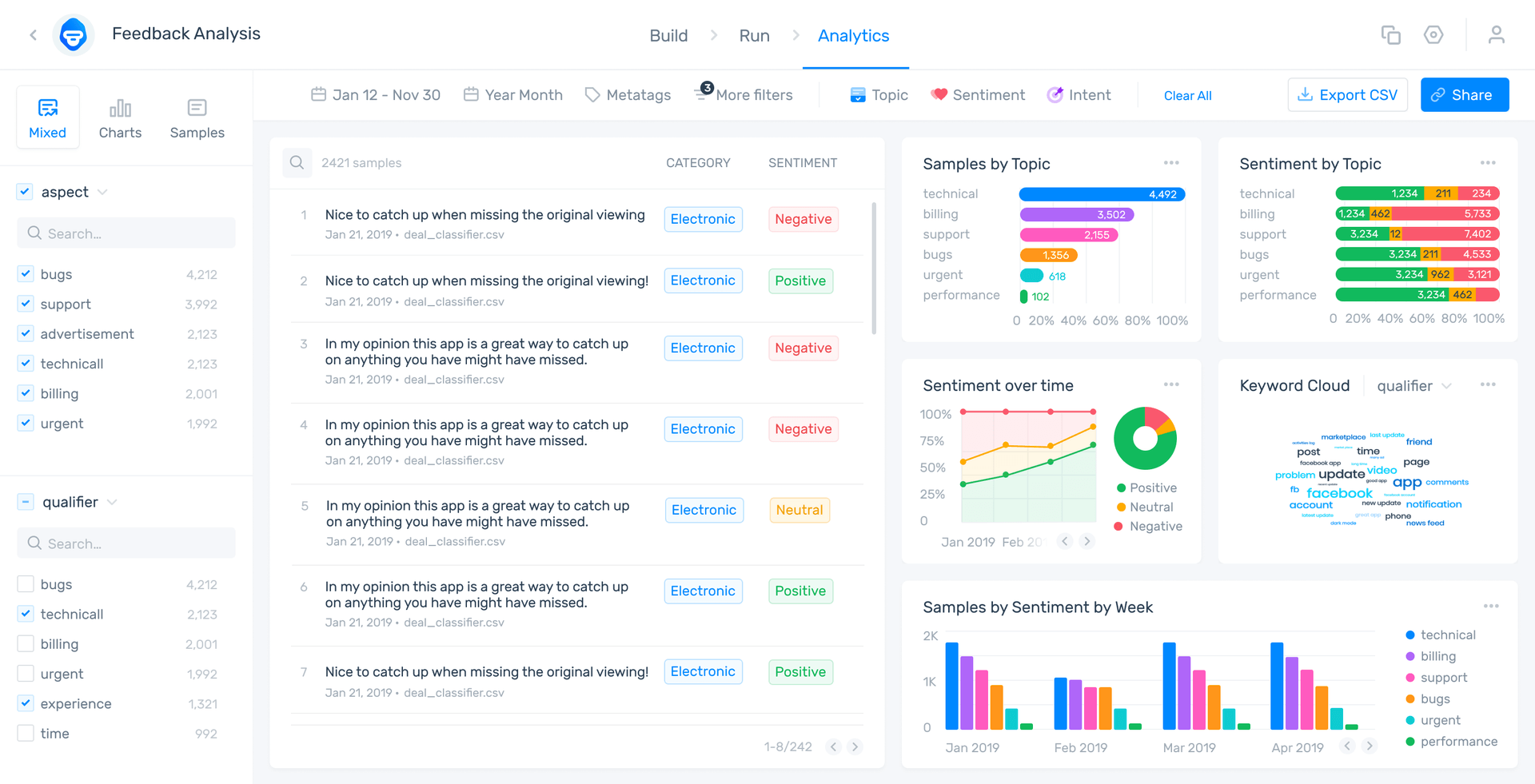How to Set Up a Voice of Customer Program & Why You Need It

As the pandemic winds down, we’re entering a new era of customer experience (CX).
Customers expect more than ever from the brands they use. They expect products and services to perform exactly to their needs – easy to set up, easy to use, etc. – and more personalized and empathetic customer service.
In 2022, customers want to get in touch with your company from wherever they choose – in-app, on live chat, email, phone, etc. In fact, a recent Zendesk CX trends report shows that 64% of customers used a completely new support channel in 2020 and 73% of them plan to continue using it.
Providing omnichannel support comes with many challenges for businesses, but with a robust VoC (voice of customer) program in place, you can easily overcome them. You need to know how to listen to your customers, how to open more channels of communication, how to support them right away when you do, and how to analyze the information you receive for future success.
In this guide, learn how to create your voice of customer program, so you can get to know your customers better.
- What Is a Voice of Customer Program?
- Why Your Company Needs a Voice of Customer Program
- How to Create a Voice of Customer Program
- What Your Voice of Customer Program Needs
What Is a Voice of Customer (VoC) Program?
A voice of customer (VoC) program is a collection of tools and processes that gathers and analyzes customer feedback (from customer service, social media, etc.) to improve products and services, employee training, and overall customer satisfaction.
Why Your Company Needs a Voice of Customer Program
There are endless benefits to a voice of customer program. Voice of customer analysis is designed to get into the heads of your customers, to understand their needs and desires, how they use your products, and what your products and services may be lacking. VoC allows you to follow the entire customer journey and uncover customer pain points along the way to improve the customer experience, customer satisfaction, decrease customer churn, and increase profits.
There are a number of ways to get the VoC data you need: ask customers directly with surveys and focus groups, analyze customer service data from live chats, emails, phone calls, etc., or use customer feedback from product review sites, social media, and all over the web.
There are also a variety of techniques you can use to analyze your VoC feedback, from AI-guided machine learning text analysis tools to simple spreadsheets, like Excel and Google Sheets, even online survey tools, like SurveyMonkey and Typeform offer some built-in tools.
Now let’s find out how to design a VoC system to set you up for success.
How to Create a Voice of Customer Program
Creating your custom VoC program can seem intimidating at first, but if you follow these three steps, you’ll be set up for powerful results.
3 Steps for Creating Your Voice of Customer Program
Collect VoC data: Set goals to understand what kind of data you need.
Analyze your VoC data: Put machine learning or website analytics tools to work.
Act on your VoC results: Use your results to improve customer satisfaction and “close the customer feedback loop.”
1. Collect voice of customer data
You’re probably already collecting a lot of relevant data from internal customer support systems: emails, online chats, in-app communications, etc. This data will help you dig into customer needs and uncover continually occurring problems.
You can also perform regular Net Promoter Score (NPS) and customer satisfaction (CSAT) surveys. Online survey tools make them easy to customize and easy to execute – in-app, on your website, via chatbot, or in emails. You can present quantitative questions with simple “Yes/No” or “On a scale of 1 to 10” responses. Or you can dig deeper into the opinions and feelings of your customers with qualitative, open-ended questions that offer results that you may have never even considered.
You can even collect customer opinions and feedback from social media, news reports, online reviews, and forums with web scraping tools or connect directly to sites, like Twitter and Facebook with APIs.
2. Analyze your voice of customer data
The data you collect will determine the kinds of tools and techniques you’ll need to use. Excel data analysis is great for crunching numbers, like customer bounce rates, sign ups, time spent using your app, etc. Machine learning text analysis tools, on the other hand, can analyze open-ended customer opinions for more in-depth and nuanced results.
MonkeyLearn is a SaaS text analysis platform with easy-to-use tools and powerful techniques, like topic-based sentiment analysis, that can automatically understand the ideas, opinions, and feelings of your customers in real time.
For example, comments about your company on Twitter can be run through MonkeyLearn’s pre-trained sentiment analyzer:

Sentiment analysis easily tags this tweet as “Negative.” The great thing about machine learning tools, like MonkeyLearn, is you can train them to the language and criteria of your business for results that are much more accurate than human analysis ever could be.
Once you’ve mastered sentiment analysis, you can take it a step further, with topic analysis, to tag text for “aspects” or categories, like Pricing, Features, Usability, etc.
MonkeyLearn Studio is an all-in-one text analysis and visualization platform that can bring your company’s VoC to life in broad strokes or striking detail. Take a look at this aspect-based sentiment analysis of VoC from online reviews of Zoom:

See each customer opinion separated by topic: Usability, Support, Features, Pricing, etc., then by sentiment, so we understand which aspect of the business is particularly Positive and which is Negative.
3. Act on your VoC results
Now you have your results, and it’s time to put them into practice.
Perhaps it turns out that onboarding is a recurring issue, something that could come up in an aspect-based sentiment analysis of customer support interactions. You can put new employee training processes into practice, improve your FAQs, or automate chatbots with the information your customers need to walk them through the process.
MonkeyLearn Studio can help you understand where to aim your focus. You can dig into exactly the data you need and change techniques and tools directly in the dashboard.
What Your Voice of Customer Program Needs
Multi-channel approach to gather data.
Setting up a customer support ticket management system will help funnel all of your customer feedback into a single system, so the most pressing issues will be taken care of first, your staff will be informed of issues they’re responsible for, and you’ll be collecting relevant data for VoC analysis. 2020 saw huge increases in customer support channels, up 110% on social messaging, 75% on SMS/Text, and 36% in-app. You need omnichannel customer service to meet your customers where they are, and machine learning tools can help set it up.
From there you can perform regular survey analysis to ask customers the questions you need answered and social listening techniques to search out unsolicited customer opinions (on review sites, Twitter, Facebook, and more, which often turn out to be the most honest.
Gather both quantitative and qualitative data.
Use Excel, Google Sheets, etc., to break down quantitative data like sales figures, demographics, income, etc. But don’t be afraid to dive into qualitative data with open-ended survey questions, online feedback examination, and email and chat analysis. Machine learning tools can do the heavy lifting for you, and once they’re set up, they can run 24/7 with little need for human interaction.
Gather employee insights.
Don’t forget about your employees! They’re regularly interacting with customers and may often know their needs better than the customers themselves. Setting up a VoE (voice of employee) program works similarly to voice of customer, but on the inside of the company. It will help to understand your employees’ needs and pain points to improve their job satisfaction and set them up to better serve your customers.
Put a VoC Program to Work
Voice of customer analysis can offer huge insights by listening to your customers wherever they may be leaving feedback. Understanding your customers’ opinions, feelings, and habits is key to improving their satisfaction and, ultimately, your bottom line.
Take a look at MonkeyLearn to check out what powerful machine learning text analysis tools can do for your business.
Or, request a demo to see how you can get the ball rolling with your own VoC program.

Rachel Wolff
March 10th, 2021






